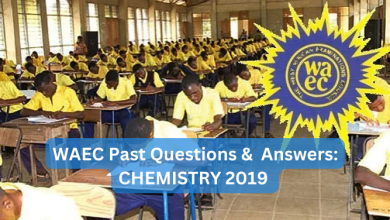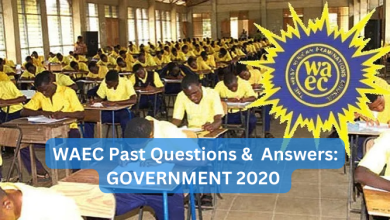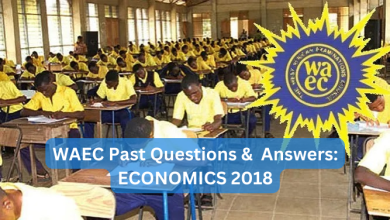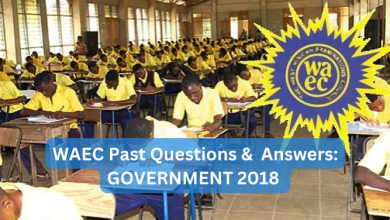WAEC Past Questions & Answer: CHEMISTRY 2022

Welcome to our WAEC past question and answer series. In this post, we will be sharing Chemistry 2022 past questions and their answers for various subjects. Stay tuned enjoy while learning.
1. The by-product of fermentation of sugar is
A. carbon(IV) oxide.
B. ethanoic acid.
C. propanol
D. propan-1, 2, 3- triol.
2. Which of the following sugars is a product of the condensation of monosaccharides?
A. galactose
B. maltose
C. glucose
D. fructose
3. The cleansing effect of soap is low in acidic water because of
A. the formation of unionised fatty acid.
B. increase in the pH of the soap molecules.
C. anti-biodegradable effect of hydrogen ions
D. the hardness of the acidic water.
4. The following compounds are condensation polymers except
A. nylon
B. protein
C. starch
D. polythene
5. What amount of electricity is required to deposit one mole of aluminium from a solution of AlCl3?
A. One Faraday
B. One ampere
C. Three Faradays
D. Three amperes
6. Which of the following compounds would react rapidly with bromine?
A. Benzene
B. Hexane
C. Hexene
D. Hexanol
7. Alkanols can be manufactured from alkenes by the initial reaction of alkenes with
A. bromine in tetrachloromethane
B. concentrated tetraoxosulphate(VI) acid
C. aqueous potassium tetraoxomanganate(VII).
D. sodium hydroxide solution.
8. Which of the following statements about the standard hydrogen electrode is not correct?
A. The hydrogen gas is at a pressure of 1 atmosphere
B. A solution containing 1 mol dm-3 of H+ (aq) ions is used
C. A platinum electrode is used
D. The temperature is kept at 20 °C
9. If 60 g of M combines with 24 g of oxygen, what would the empirical formula of the oxide be?
A. MO
B. MO2
C. MO3
D. MO4
10. The products of the electrolysis of dilute sodium chloride using carbon electrodes are
Anode Cathode
A. chlorine and sodium.
B. oxygen and hydrogen.
C. chlorine and hydrogen.
D. hydrogen and oxygen.
11. Determine the quantity of electricity used when a current of 0.20 amperes is passed through an electrolytic cell for 60 minutes.
A. 12C
B. 120C
C. 360C
D. 720C
12. Oxochlorate(I) acid is used as a bleaching agent because it is
A. a weak acid
B. a reducing agent.
C. an oxidising agent
D. a strong acid.
13. The IUPAC name for CH3CHCH3CHCLCHCH3CH2CH3 is
A. 2, 4 – dimethyl – 3 – chlorohexane
B. 3, 5 – dimethyl – 4 – chlorohexane
C. 4 – chloro – 3, 5 – dirnethylhexane
D. 3 – chloro – 2, 4 – dimethylhexane
14. A colourless gas with a pungent smell is evolved when dilute hydrochloric acid is added to a sample of a salt. The gas evolved could turn
A. acidified K2Cr2O7 solution colourless
B. acidified KMnO4 solution colourless
C. Fe(NO3)2 solution green
D. Pb(NO3)2 paper black
15. If 5.0 g of marble reacts with 25.0 cm3 hydrochloric acid, which of the following combinations has the fastest reaction rate?
A. Marble chips and 2.0 mol dm−3 HCl(aq)
B. Marble chips and 2.5 mol dm−3 HCl(aq)
C. Powdered marble and 2.5 mol dm−3 HCl(aq)
D. Powdered marble and 2.0 mol dm−3 HCl(aq)
16. Increasing the temperature generally
A. decreases the solubility of a solid in a liquid but increases the solubility of a gas in a liquid.
B. increases the solubility of a solid in a liquid but decreases the solubility of a gas in a liquid.
C. increases the solubility of both a solid and a gas in a liquid
D. decreases the solubility of both a solid and a gas in a liquid
17. A white precipitate was formed when BaCl2(aq) was added to an aqueous solution
of a salt X. The precipitate dissolved in dilute HCl with rapid effervescence. Salt X is likely to contain
A. SO4 2− ions
B. SO3 2− ions
C. NO3- ions
D. SO3 2−- ions
18. Before a reaction could take place, there should be
A. ionisation of reactant particles
B. breakage of bonds of products
C. breakage of bonds of reactants
C. ionisation of product particles
19. Consider the following reaction equation:
CaO + SiO2 ——> CaSiO3
Silicon(IV) oxide is acting as
A. a basic oxide
B. a reducing agent
C. an acidic oxide
D. an oxidising agent
20. Which of the following acids would form normal salt only?
A. Tetraoxosulphate(VI) acid
B. Trioxonitrate(V) acid
C. Tetraoxophosphate(V) acid
D. Trioxosulphate(IV) acid
21. What is the partial pressure of oxygen at s.t.p. in a gaseous mixture containing 100 cm3 of oxygen and 900 cm3 of nitrogen gas?
A. 1.0 atm
B. 0.1 atm
C. 9.0 atm
D. 0.9 atm
22. Graphite is used as a dry lubricant due to the presence of
A. mobile electrons
B. free electrons
C. octahedral structures
D. layered structures
23. Which of the following gases is alkaline?
A. NO2
A. NH3
B. CO2
D. N2O
24. Which of the following statements about an equilibrium system is correct?
A. Forward and backward reactions occur at the same rate
B. The concentrations of reactants must equal that of the products
C. The concentrations of, reactants and products can be changed by adding a catalyst,
D. The concentrations of reactants and products are not affected by a change in temperature
25. Consider the following reaction equation
N2(g) + 3H2(g); ∆H = -92kJ
A. shift the equilibrium to the right
B. increase the yield of ammonia
C. decrease the amount of hydrogen
D. decrease the yield of ammonia
26. When air in a syringe is compressed such that there is no change in temperature, the
A. air liquefies
B. pressure increases
C. intermolecular space increases
D. density decreases
27. Which of the following statements about liquids is/are true?
I. Liquids maintain their volume at constant temperature.
II. Liquids have fixed shape
III. Liquids do not diffuse
IV. Change in pressure affects volume of liquids
A. I only
B. IV only
C. I and IV only
D. II and III only
28. A hydrogen chloride gas reacted with oxygen gas to yield water and chlorine gas. The mole ratio of the hydrogen chloride gas to water is
A. 1:3
B. 2:1
C. 3:1
D. 4:1
29. What number of moles of oxygen would exert a pressure of 10 atm at 320 K in an 8.2 dm3 cylinder?
[R=0.082 atm dm−3 mol−1 K−1]
A. 0.32
B. 1.52
C. 3.13
D. 31.25
30. If 50 cm3 of a saturated solution of KNO3 at 40 °C contained 5:05 g of the salt, its solubility at the same temperature would be
[KNO3 = 101]A. 1.5 mol dm−3
B. 1.5 mol dm−3
C. 2.0 mol dm−3
D. 5.0 mol dm−3
31. Which of the following elements would displace copper from a solution of copper ions?
A. silver
B. gold
C. lead
D. mercury
32. What is the percentage composition of carbon
in Ca(HCO3)2 ?
[ Ca = 40.0, 0= 16.0, C = 12.0, H= 1.0]
A. 22.2%
B. 14.8%
C. 7.4%
D. 3.7%
33. Which of the following bond types is intermolecular?
A. Covalent bond
B. Hydrogen bond
C. Ionic bond
D. Metallic bond
34. The maximum number of covalent bonds formed by nitrogen is
A. 1
B. 2
C. 3
D. 4
35. The IUPAC name of the compound CH3CH(CH3)CHCH2 is
A. 2 – methyl but – 1 – ene
B. 2 – methyl but – 2 – ene
C. 3 – methyl but – 1 – ene
D. 3 – methyl but – 2 – ene
36. Ionisation energy increases across the period in the periodic table because
A. atomic number increases
B. effective nuclear charge increases
C. mass number decreases
D. screening effect decreases
37. Which of the following properties indicate that an element is a metal. It
I. reacts with oxygen to form an acidic oxide
II. forms ionic chlorides
III. has variable oxidation states
IV. displaces hydrogen from dilute HCl
A. I and III only
B. I and II only
C. II and IV only
D. I, II, III and IV
38. The electron configuration of carbon atom in its excited state is
A. 1s22s22px22py0
A. 1s22s22px12py1
C. 1s22s12px12py12pz1
D. 1s12s22px12py1
39. An oxide has the following properties. It
I. is a white powder
II. reacts with HCI.
III. reacts with NaOH
IV. is insoluble in water
The oxide is
A. alkaline
B. amphoteric
C. acidic
D. neutral
40. Which of the following statements about atoms of a metal is correct? They
A. readily accept electrons
B. are soft
C. are held together by covalent bond
D. are held together by a sea of electron cloud
41. The atom with the electron configuration
1s22s22p63s23p63d104s24p4 is in
A. period 4, p- block
B. period 3, p- block
C. period 4, d- block
D. period 3, d- block
42. Electro-positivity of elements across the periodic table normally
A. remains constant down the group
B. increases across the period
C. decreases across the period
D. decreases down the group
43. Consider the following table
Substitute Melting point / ºC Boiling point / ºC
P – 78 -25
Q – 8 40
R – 6 150
S 44 280
Which of the substances is a liquid at room temperature and rapidly evaporates on exposure to air?
A. P
B. Q
C. R
D. S
44. Which of the following oxides is amphoteric?
A. Carbon(II) oxide
B. Nitrogen(IV) oxide
C. Lead(II) oxide
D. Calcium oxide
45. Which of the following processes occur during fractional distillation of petroleum?
A. Condensation and diffusion
B. Diffusion and evaporation
C. Diffusion and sublimation
D. Evaporation and condensation
46. If the molar mass of X(HCO3)2 is 162 g mol−1, determine the relative atomic mass of X.
[H = 1.0, C = 12.0, 0 = 16.0]A. 40
B. 48
C. 61
D. 101
47. Charcoal is used in the decolourization of sugar because of its
A. absorption property.
B. amorphous property.
C. oxidising property.
D. adsorption property.
48. The first definition of an element was made by
A. J. Dalton.
B. A. Lavoisier.
C. R. Boyle.
D. J. J. Thompson.
49. Which of the following scientists formulated the law of conservation of mass?
A. A. Lavoisier
B. J. Dalton
C. R. Boyle
D. J. Proust
50.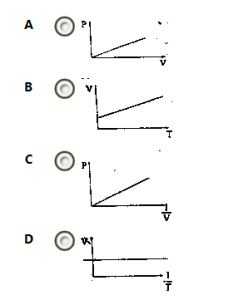
Which of the following sketches is a graphical representation of Boyle’s law?
A. A
B. B
C. C
D. D
Answers To Questions
- A
- B
- A
- D
- C
- C
- B
- D
- C
- B
- D
- C
- D
- B
- C
- B
- D
- C
- C
- A
- B
- D
- A
- A
- D
- B
- A
- B
- C
- A
- C
- B
- B
- D
- C
- B
- C
- C
- B
- D
- A
- C
- B
- C
- D
- A
- D
- C
- A
- C

